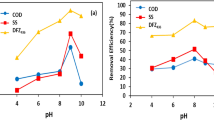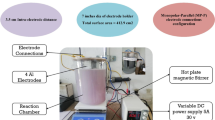Abstract
Electrocoagulation process (EC) is one of the best economic methods for industrial textile dyeing wastewater treatment; however, produced sludge is the main problem of this method. So sludge settling velocity (SSV) and filtering time (FT) of sludge are effective on area requirement and operating costs. Effect of four operational parameters including electrodes type, pH, current density and electrodes distance was investigated on SSV and FT. Decolorization and chemical oxygen demand (COD) removal of wastewater were checked. The results showed the more effect of electrodes type rather than of variable parameters. SSV and FT were 0.02–0.14 cm/min, 0.2–8.34 min for Al electrodes and 0.05–1.55, 0.42–2.78 min for Fe electrodes at all conditions. Also decolorization and COD removal were 62–94.5, 14.74–36.74% for Al electrodes arrangement and 83.91–94.59, 24.6–44.45% for Fe electrodes arrangement. Comparison between Al and Fe electrodes showed that Fe electrodes were better than Al for filtration and settling after EC process. Fe electrodes have high impact on SSV and FT, but have no effect on decolorization and COD removal. Optimum condition was initial pH of 7.43, current density of 5 mA/cm2 and electrodes distance of 0.5 cm, which SSV, decolorization and COD removal were 1.72 cm/min, 83.78 and 35.48%, respectively.




Similar content being viewed by others
References
Akyol A, Can OT, Bayramoglu M (2015) Treatment of hydroquinone by photochemical oxidation and electrocoagulation combined process. J Water Process Eng 8:45–54
Alinsafi A, Khemis M, Pons M, Leclerc J, Yaacoubi A, Benhammou A, Nejmeddine A (2005) Electro-coagulation of reactive textile dyes and textile wastewater. Chem Eng Process 44:461–470
Aoudj S, Khelifa A, Drouiche N, Hecini M, Hamitouche H (2010) Electrocoagulation process applied to wastewater containing dyes from textile industry. Chem Eng Process 49:1176–1182
Asghar A, Raman AAA, Daud WMAW (2015) Advanced oxidation processes for in situ production of hydrogen peroxide/hydroxyl radical for textile wastewater treatment: a review. J Clean Prod 87:826–838
Aziz ARA, Asaithambi P, Daud WMABW (2016) Combination of electrocoagulation with advanced oxidation processes for the treatment of distillery industrial effluent. Process Saf Environ Prot 99:227–235
Behbahani M, Alavi Moghaddam M, Arami M (2011) A comparison between aluminum and iron electrodes on removal of phosphate from aqueous solutions by electrocoagulation process. Int J Environ Res 5:403–412
Can O, Kobya M, Demirbas E, Bayramoglu M (2006) Treatment of the textile wastewater by combined electrocoagulation. Chemosphere 62:181–187
Chafi M, Gourich B, Essadki A, Vial C, Fabregat A (2011) Comparison of electrocoagulation using iron and aluminium electrodes with chemical coagulation for the removal of a highly soluble acid dye. Desalination 281:285–292
Chavalparit O, Ongwandee M (2009) Optimizing electrocoagulation process for the treatment of biodiesel wastewater using response surface methodology. J Environ Sci 21:1491–1496
Chowdhury M, Mostafa M, Biswas TK, Saha AK (2013) Treatment of leather industrial effluents by filtration and coagulation processes. Water Resour Ind 3:11–22
Clesceri LS, Association APH (1996) Standard methods for the examination of water and wastewater, supplement. American Public Health Association, Washington, DC
Freire D, Sant’Anna G (1998) A proposed method modification for the determination of COD in saline waters. Environ Technol 19:1243–1247
Ghanbari F, Moradi M, Eslami A, Emamjomeh MM (2014) Electrocoagulation/flotation of textile wastewater with simultaneous application of aluminum and iron as anode. Environ Process 1:447–457
Gomes JA, Daida P, Kesmez M, Weir M, Moreno H, Parga JR, Irwin G, McWhinney H, Grady T, Peterson E (2007) Arsenic removal by electrocoagulation using combined Al–Fe electrode system and characterization of products. J Hazard Mater 139:220–231
González T, Domínguez JR, Beltrán-Heredia J, García HM, Sanchez-Lavado F (2007) Aluminium sulfate as coagulant for highly polluted cork processing wastewater: evaluation of settleability parameters and design of a clarifier-thickener unit. J Hazard Mater 148:6–14
Kobya M, Gengec E, Demirbas E (2016) Operating parameters and costs assessments of a real dyehouse wastewater effluent treated by a continuous electrocoagulation process. Chem Eng Process 101:87–100
Linares-Hernández I, Barrera-Díaz C, Roa-Morales G, Bilyeu B, Ureña-Núñez F (2009) Influence of the anodic material on electrocoagulation performance. Chem Eng J 148:97–105
Liu X, Chen Z, Wang L, Wu Y, Garoma T (2012) RETRACTED: degradation of polycyclic musk HHCB in water by O3, UV, and UV/O3. J Photochem Photobiol A 230:1–9
Moreno-Casillas HA, Cocke DL, Gomes JA, Morkovsky P, Parga J, Peterson E (2007) Electrocoagulation mechanism for COD removal. Sep Purif Technol 56:204–211
Myer RH, Montgomery D (2002) Response surface methodology. Process and product optimization using designed experiment, vol second. Wiley, New York
Myers RH, Montgomery DC, Anderson-Cook CM (2016) Response surface methodology: process and product optimization using designed experiments. Wiley, New York
Naje AS, Chelliapan S, Zakaria Z, Abbas SA (2016) Electrocoagulation using a rotated anode: a novel reactor design for textile wastewater treatment. J Environ Manage 176:34–44
Pajootan E, Arami M, Mahmoodi NM (2012) Binary system dye removal by electrocoagulation from synthetic and real colored wastewaters. J Taiwan Inst Chem Eng 43:282–290
Parsa JB, Vahidian HR, Soleymani A, Abbasi M (2011) Removal of Acid Brown 14 in aqueous media by electrocoagulation: optimization parameters and minimizing of energy consumption. Desalination 278:295–302
Radaidah JA, Al-Zboon KK (2011) Increase the efficiency of conventional sand drying beds by using intensive solar energy: a case study from Jordan. System 7:12–13
Radaideh JA, Ammary BY, Al-Zboon KK (2010) Dewaterability of sludge digested in extended aeration plants using conventional sand drying beds. Afr J Biotechnol 9:4578–4583
Saakov VS, Krivchenko AI, Rozengart EV, Danilova IG (2015) Derivative spectrophotometry and PAM-fluorescence in comparative biochemistry. Springer, Berlin
Sharma D (2014) Treatment of dairy waste water by electro coagulation using aluminum electrodes and settling, filtration studies. Membranes 95:19
Song S, He Z, Qiu J, Xu L, Chen J (2007) Ozone assisted electrocoagulation for decolorization of CI Reactive Black 5 in aqueous solution: an investigation of the effect of operational parameters. Sep Purif Technol 55:238–245
Tran N, Drogui P, Blais J-F, Mercier G (2012) Phosphorus removal from spiked municipal wastewater using either electrochemical coagulation or chemical coagulation as tertiary treatment. Sep Purif Technol 95:16–25
Un UT, Aytac E (2013) Electrocoagulation in a packed bed reactor-complete treatment of color and cod from real textile wastewater. J Environ Manage 123:113–119
Wu C-H, Chang C-L, Kuo C-Y (2008) Decolorization of procion red MX-5B in electrocoagulation (EC), UV/TiO 2 and ozone-related systems. Dyes Pigment 76:187–194
Yuksel E, Gurbulak E, Eyvaz M (2012) Decolorization of a reactive dye solution and treatment of a textile wastewater by electrocoagulation and chemical coagulation: techno-economic comparison. Environ Progress Sustain Energy 31:524–535
Acknowledgements
The authors would like to thank Mrs Shilan Elyasi for her kind assistance.
Author information
Authors and Affiliations
Corresponding author
Additional information
Editorial responsibility: M. Abbaspour.
Rights and permissions
About this article
Cite this article
Ghaffarian Khorram, A., Fallah, N. Comparison of sludge settling velocity and filtration time after electrocoagulation process in treating industrial textile dyeing wastewater: RSM optimization. Int. J. Environ. Sci. Technol. 16, 3437–3446 (2019). https://doi.org/10.1007/s13762-018-1731-x
Received:
Revised:
Accepted:
Published:
Issue Date:
DOI: https://doi.org/10.1007/s13762-018-1731-x




